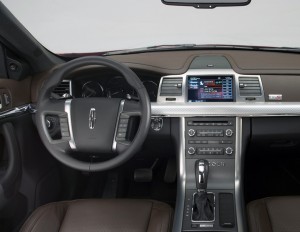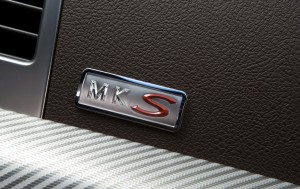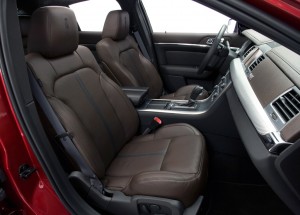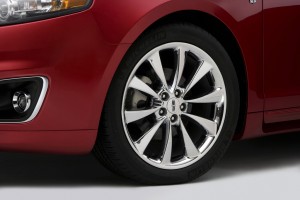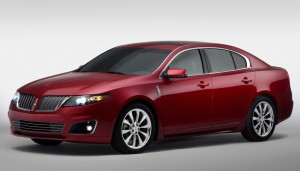
The Lincoln MKS has a rather conservative design, but the performance of it's optional 3.5-liter twin-turbo V-6 is anything but conservative.
Here’s the problem with the Lincoln MKS, as it stands for 2011. The Ford Edge/Lincoln MKZ twins.
Yes, the MKS’ new EcoBoost engine is awesome, providing an extra 82 horsepower over the standard 3.7-liter V-6 with better fuel economy to boot. But the rest of the car is largely unchanged.
This year, Ford is introducing MyFordTouch – MyLincolnTouch in Lincolns – a new graphical interface for the automaker’s Sync infotainment system. First to get the new system are the Edge and MKX corssovers.
Instead of the slick soft-touch buttons or optional touch screen system, the MKS, Lincoln’s flagship car, soldiers on with Ford’s old-style center console, old-tech instrument panel and antiquated steering wheel design.
It’s still a compelling luxury car. Where many other cars in this class have trended toward the sports sedan category, the MKS is different. If an Audi A6 or BMW 5-Series is just too edgy for you, the MKS might be more your speed.
EcoBoost is a rather strange name for an engine which is essentially a high-performance option. Regardless what Ford calls it, this twin-turbocharged and direct-injected 3.5-liter V-6 is a sweet piece. Normally, more horsepower usually equals fewer mpgs, but not with the EcoBoost. An all-wheel-drive MKS with the standard 273-horsepower engine is rated at 16 mpg city and 23 highway. The Ecoboost engine, which is only available with all-wheel drive, is rated at 17/25. One difference is that premium fuel is recommended for the EcoBoost to obtain maximum performance while the regular engine drinks regular.
The turbocharged engine provides a satisfying push in the back and a noticeable improvement in acceleration. Acceleration drops from the mid 7-second range to the mid-5s, which is quite an improvement for 82 horses. A lower (numerically higher) final drive ratio helps with acceleration.
The MKS handles nicely, even if there isn’t much feedback in the steering. The ride is smooth, although small pavement imperfections are felt through the backside.
The back seat is comfortable for two, doable for three. At 18.7 cubic feet, the trunk will accept a lot of luggage. But the narrow opening and high liftover height are negatives. One annoyance of all of the cars built on this platform – including the Ford Taurus, Ford Flex and Lincoln MKT – is a sizable hump on the floor at the leading edge of the front seats.
The front seats tend toward comfort, not sport, so they’re not up to the task for seriously aggressive driving. The Bridge of Weir leather is beautiful and nice to the touch.
Even if Ford hadn’t one-upped its own flagship with the new Edge and MKX, the MKS, introduced in 2009, was still behind cars from other makers in this class in terms of interior flash. While the stitched dash covering is luxurious, many of the buttons, lighting and displays are Ford parts-bin stuff.
A combination of being among the quiets cars sells coupled with smallish interior volume – compared to the MKT crossover – make MKS the best for using Sync. Still, driving a couple of dozen Sync-equipped Fords during the last few years has shown that each one has its idiosyncracies. This one was reluctant to let go of phone calls and refused to download phonebooks.
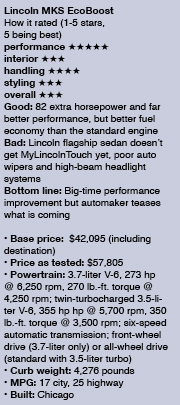 The Chiclet-size buttons for the stereo and climate control are arranged in tight rows, making them difficult to push, especially with gloved fingers. Many of the dash lights do not glow evenly because they are lit by old-fashioned bulbs.
The Chiclet-size buttons for the stereo and climate control are arranged in tight rows, making them difficult to push, especially with gloved fingers. Many of the dash lights do not glow evenly because they are lit by old-fashioned bulbs.
But perhaps most annoying were the MKS’ auto-dimming headlights and rain-sensing wipers.
First the headlights. With the headlights set on automatic, the system is supposed to automatically turn on the high beams when there are no cars in front of it and turn on the low beams when there are. During one night-time drive, the system repeatedly refused to turn on the high beams when it could, then flashed oncoming drivers just as we approached.
With the wipers, one morning there was some stubborn dew on the windshield. Even after wiping most of the dew away, the wipers insisted on wiping on high speed. Here’s the deal, rain-sensing wipers should never operate at high speed automatically. If high speed is needed, leave it to the driver. During normal rain, the system worked better.
The exterior design is fairly conservative. The split-wing grille is nice and the basic shape is good, but it doesn’t stand out like a lot of cars in this class. For some buyers, that will be a selling point. Others will want more flash. Maybe the ones who prefer the MKS’ softer ride will also approve of its less-aggressive style.
It’s not that the MKS EcoBoost can’t do aggressive. Drivers of many sports sedans that are supposedly more performance-oriented might look on in disbelief as one of these demure-looking sedans blows them away in a stoplight drag race to the freeway entrance.
A front-wheel drive MKS with the base V-6 starts at $42,095. The EcoBoost with standard all-wheel drive and the turbo engine starts at $48,985. Add in options including a $3,500 package that features voice-activated navigation, rear-view camera, upgraded stereo and dual-pane sunroof and a $2,995 appearance package for an as-tested price of $57,805.
MyLincolnTouch will eventually make its way to more cars within Ford’s lineup, including the MKS. Until then, the MKS EcoBoost is a lot of engine in a conservative business suit waiting for the interior upgrade that is surely on its way.

